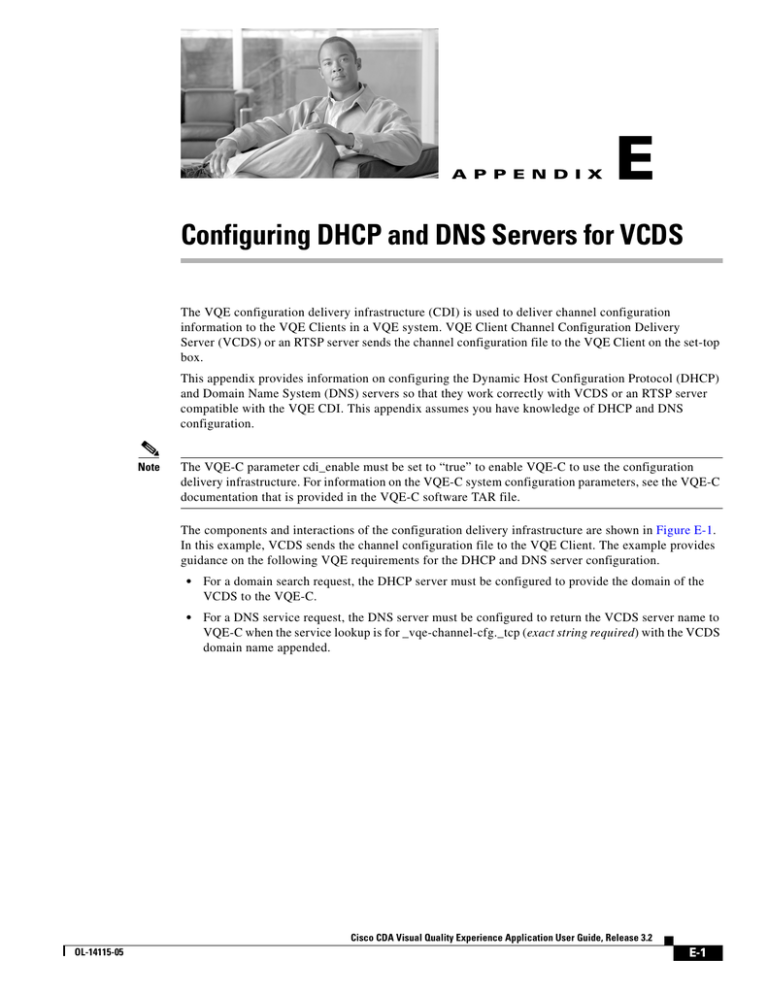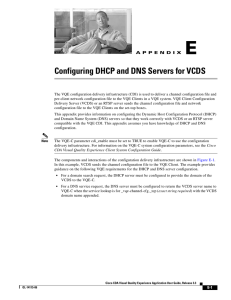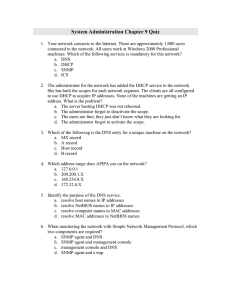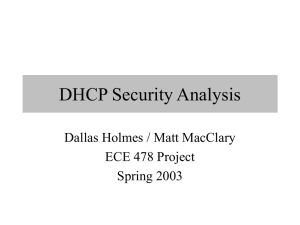Appendix E: Configuring DHCP and DNS Servers for VCDS
advertisement

A P P E N D I X E Configuring DHCP and DNS Servers for VCDS The VQE configuration delivery infrastructure (CDI) is used to deliver channel configuration information to the VQE Clients in a VQE system. VQE Client Channel Configuration Delivery Server (VCDS) or an RTSP server sends the channel configuration file to the VQE Client on the set-top box. This appendix provides information on configuring the Dynamic Host Configuration Protocol (DHCP) and Domain Name System (DNS) servers so that they work correctly with VCDS or an RTSP server compatible with the VQE CDI. This appendix assumes you have knowledge of DHCP and DNS configuration. Note The VQE-C parameter cdi_enable must be set to “true” to enable VQE-C to use the configuration delivery infrastructure. For information on the VQE-C system configuration parameters, see the VQE-C documentation that is provided in the VQE-C software TAR file. The components and interactions of the configuration delivery infrastructure are shown in Figure E-1. In this example, VCDS sends the channel configuration file to the VQE Client. The example provides guidance on the following VQE requirements for the DHCP and DNS server configuration. • For a domain search request, the DHCP server must be configured to provide the domain of the VCDS to the VQE-C. • For a DNS service request, the DNS server must be configured to return the VCDS server name to VQE-C when the service lookup is for _vqe-channel-cfg._tcp (exact string required) with the VCDS domain name appended. Cisco CDA Visual Quality Experience Application User Guide, Release 3.2 OL-14115-05 E-1 Appendix E Figure E-1 Configuring DHCP and DNS Servers for VCDS VQE Configuration Delivery Infrastructure VQE-Client DHCP Server DNS Server VCDS DHCP domain search “iptv.myvqec.com” SRV lookup for “_vqe-channel-cfg._tcp.iptv.myvqec.com” “vqe-channel-cfg-server.iptv.myvqec.com” DESCRIBE rtsp://vqe-channel-cfg-server.iptv.myvqec.com/channel-config RTSP/1.0” RTSP/1.0 200 OK with SDP descriptions for the entire channel set As shown in Figure E-1, the interactions between the VQE Client and the other components of the configuration delivery infrastructure are as follows: 1. The VQE-C on the set-top box sends out a DHCP domain search request. 2. The DHCP Server returns the domain (in this example, iptv.myvqec.com) that the VCDS is part of. The domain is user-defined and configured in the DHCP server. 3. After receiving the domain name from the DHCP server, VQE-C makes a DNS service request for the following string: _vqe-channel-cfg._tcp.iptv.myvqec.com Note The _vqe-channel-cfg._tcp part of the string is hardcoded in VQE-C and is not configurable. The DNS server must be configured for this exact string (_vqe-channel-cfg._tcp) with the domain name appended. 4. The DNS server responds with the VCDS server name defined in SRV records. 5. If the query is successful, VQE-C parses out the VCDS server name from the DNS server response. VQE-C sends out an RTSP DESCRIBE request for the channel configuration data to the VCDS server. 6. VCDS receives the request and sends back the channel configuration data for the entire channel set in SDP format. If the RTSP DESCRIBE operation succeeds, the VQE-C attempts to update the local channel_lineup file. If the DNS query or the RTSP DESCRIBE operation fails, the VQE-C attempts to retrieve the channel configuration locally if a channel_lineup file is specified in the VQE-C system configuration file. If the appropriate channel configuration cannot be obtained, the VQE-C does not perform error repair. Cisco CDA Visual Quality Experience Application User Guide, Release 3.2 E-2 OL-14115-05






